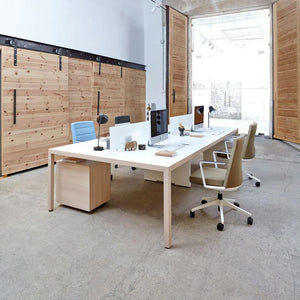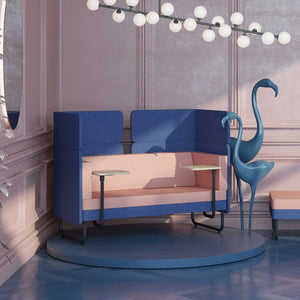
What Should Be Included In An Office Design?
Office design plays a crucial role in creating a productive and comfortable workspace. A well-designed office not only enhances productivity but also contributes to the well-being of employees. This article will explore the various aspects of office design and highlight key elements that should be included.
Understanding the importance of office design
Office design goes beyond aesthetics. It can significantly impact both productivity and employee well-being. Creating an office environment that promotes collaboration, creativity, and efficiency is essential for any business.
When it comes to office design, there is more than meets the eye. It is not just about choosing the right colour scheme or stylish furniture. The layout, lighting, and even the smallest details can have a profound effect on how employees feel and perform in their workspace.
Imagine walking into an office with dim lighting, cramped cubicles, and a constant hum of noise. It's not the most inspiring or motivating environment, is it? On the other hand, picture a bright and spacious office with large windows, comfortable seating, and well-organized workstations. This kind of office can make a world of difference in employee productivity and well-being.
The impact of office design on productivity
A well-designed office can enhance productivity by providing employees with a comfortable and functional workspace. Factors such as layout, lighting, and noise control can significantly influence productivity levels.
Research has shown that natural light is not only aesthetically pleasing but also has a positive impact on employee performance. Exposure to natural light can help regulate the body's internal clock, improve mood, and increase alertness. By incorporating large windows and skylights into the office design, businesses can harness the power of natural light to boost productivity.
Ergonomic furniture is another crucial aspect of office design that can improve productivity. Chairs and desks that are adjustable and provide proper support can prevent discomfort and reduce the risk of musculoskeletal disorders. When employees are physically comfortable, they can focus better on their work and avoid distractions caused by discomfort.
An organized layout is also vital for productivity. When everything is in its place and easily accessible, employees can navigate their workspace efficiently. This reduces time wasted searching for documents or supplies and allows them to stay focused on their tasks.
How office design affects employee wellbeing
Employee well-being should be a top priority for any organization. Office design plays a vital role in creating a healthy and supportive work environment.
Comfortable seating is not just about aesthetics; it can have a significant impact on employee physical health. Chairs that provide proper support and encourage good posture can prevent back pain and other musculoskeletal issues. Investing in high-quality, ergonomic chairs shows employees that their well-being is valued and can contribute to a positive work environment.
Proper lighting is another crucial factor in employee well-being. Dim lighting can cause eye strain and fatigue, leading to decreased productivity and increased stress levels. On the other hand, bright and well-distributed lighting can create a more energizing and uplifting atmosphere.
Access to nature is also essential for employee well-being. Incorporating elements such as indoor plants or creating outdoor spaces can provide employees with a connection to nature, which has been proven to reduce stress and improve mental health. A breath of fresh air during a break can do wonders for employee morale and overall well-being.
Additionally, providing spaces for relaxation and socialization can contribute to a positive work-life balance. Breakout areas or communal spaces where employees can unwind, socialize, or engage in activities such as playing games or reading can help reduce stress and foster a sense of community within the office.
As you can see, office design is not just about creating a visually appealing workspace. It has a profound impact on productivity and employee well-being. By investing in a well-designed office that considers factors such as layout, lighting, and employee comfort, businesses can create an environment that supports their employees' success and happiness.
Key elements of an effective office design
When designing an office, several key elements should be considered to create a functional and productive space. A well-designed office not only enhances the overall aesthetic appeal but also contributes to the well-being and productivity of employees.
Let's delve deeper into some of the key elements that play a crucial role in creating an effective office design.
The role of furniture in office design
Choosing the right furniture is crucial for a comfortable and ergonomic workspace. Ergonomic chairs and adjustable desks promote good posture and reduce the risk of musculoskeletal disorders. Additionally, providing a variety of seating options such as collaborative areas and standing desks can encourage movement and enhance employee engagement.
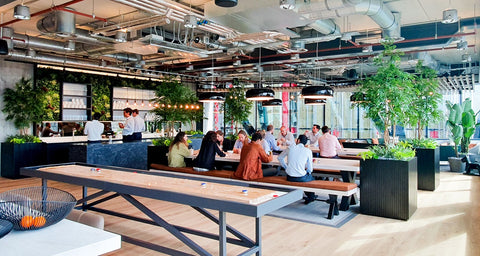
Imagine walking into an office where every employee has a personalized workspace that suits their individual needs. Some may prefer standing while working, while others may find comfort in sitting on a cosy couch. By offering a range of furniture options, employees can choose what works best for them, ultimately boosting their productivity and satisfaction.
Importance of lighting in creating a productive workspace
Lighting plays a crucial role in creating a productive workspace. Natural light is preferred as it provides numerous health benefits and enhances mood and productivity. Imagine working in an office with large windows that allow sunlight to flood the room, creating a warm and inviting atmosphere. Not only does this increase the overall aesthetic appeal, but it also improves the well-being of employees.
However, if natural light is limited, artificial lighting should be carefully chosen to avoid glare and provide sufficient illumination. The right lighting can make a significant difference in an office environment. By incorporating adjustable lighting options, employees can customize their workspace according to their preferences, ensuring a comfortable and well-lit area for maximum productivity.
The influence of colour in office environments
Colour has a significant impact on the overall ambiance of an office. Different colours have different effects on mood and productivity. For example, blue is often associated with focus and productivity, while green promotes a sense of calmness and balance. By strategically incorporating colours that align with the organization's brand and desired atmosphere, employers can create a visually stimulating environment that enhances employee morale and creativity.
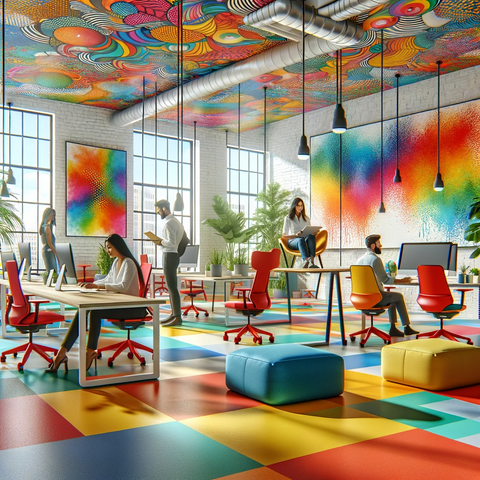
Imagine walking into an office where each department has its own unique colour scheme. The marketing department, for instance, may have vibrant and energetic colours to spark creativity, while the finance department may have more subdued tones to promote a sense of focus and concentration. By using colours strategically, employers can create an office environment that not only reflects the company's identity but also enhances the overall well-being and productivity of employees.
Designing an effective office involves careful consideration of various elements, from furniture selection to lighting choices and colour schemes. By creating a workspace that prioritizes employee comfort, well-being, and productivity, organizations can foster a positive and engaging work environment.
Incorporating technology into office design
In the modern workplace, technology plays a vital role in enhancing efficiency and collaboration. When designing an office, integrating technology seamlessly is essential.
Modern tech tools for a smart office
Advancements in technology have introduced various tools that can streamline office processes. Digital collaboration platforms, wireless connectivity, and video conferencing systems enable efficient communication and collaboration, regardless of employee location. Investing in up-to-date technology can improve workflow and productivity.
Balancing technology and comfort in office design
While technology is essential, it should not overshadow employee comfort and well-being. Providing ergonomic accessories, such as adjustable monitor arms and keyboard trays, ensures that employees can comfortably use their devices. Additionally, creating designated areas for technology use, such as quiet zones or privacy pods, can help minimize distractions.
The role of space planning in office design
Effective space planning is crucial in making the most of the available office area and promoting efficiency.
Maximising office space for efficiency
Optimizing office layout and spatial organization can significantly impact productivity. By utilizing space efficiently, employees have easy access to necessary resources and can collaborate seamlessly. Open floor plans, modular furniture, and centralized common areas can promote interaction and teamwork.
The concept of flexible spaces in modern office design
Incorporating flexible spaces in office design allows for adaptability and versatility. Creating multifunctional areas that can be easily modified to accommodate different needs fosters creativity and collaboration. This could include configurable meeting rooms, movable partitions, or adaptable workstations. Flexibility in space caters to the evolving needs of employees and facilitates a dynamic work environment.
Considering sustainability in office design
In today's world, sustainability is an essential aspect of office design.
Benefits of eco-friendly office design
Eco-friendly office design not only reduces the environmental impact but also contributes to employee well-being. Incorporating sustainable materials, energy-efficient lighting, and proper waste management promotes a healthier work environment. Employees are more likely to feel a sense of pride and satisfaction in working for an environmentally conscious organization.
Incorporating green elements into your office
Integrating green elements, such as indoor plants and green walls, can improve air quality, reduce noise levels, and create a calm and inviting atmosphere. Additionally, implementing recycling programs and encouraging sustainable practices, such as reducing paper usage, can contribute to a greener office environment.
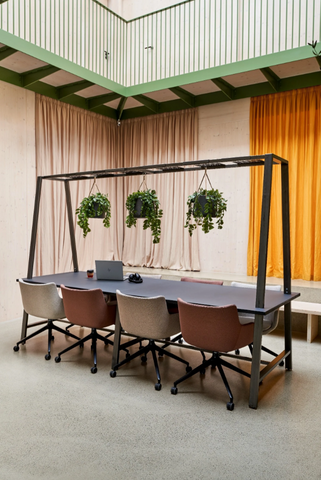
By considering the various aspects mentioned above, businesses can create office designs that not only enhance productivity but also prioritize employee well-being. A well-designed office fosters a positive and inspiring work environment, ultimately benefiting both the organization and its employees.

